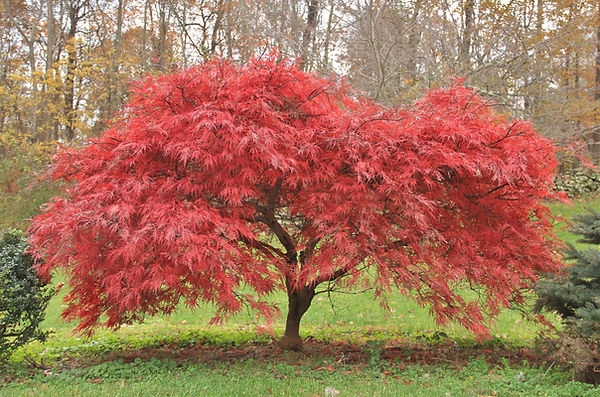Jamestown Tree
8. False Cypress Chamaecyparis obtusa
Often referred to as a Hinoki False Cypress, this conifer is native to Japan and Taiwan. A slow grower, the Hinoki can reach 50-75’ high in a pyramidal form. The leaves are dark green, flattened and fern-like in shape, with silvery striated markings on the underside. Like most of the "false cypresses" (which include the more common Leyland Cypress) the leaves release an aroma when crushed.
The bark is soft, stringy and more grey than the the other similar false cypress species. Primarily planted as ornamentals, some dwarf varieties are also found in rock gardens. The wood is used for furniture, wood veneer and panelling.

9. Native - White Ash Fraxinus americana
Also known as American Ash, the White Ash is most often found in moist soils. Its strong, straight grained wood is often preferred for lobster traps, baseball bats, hockey sticks, oars, tool handles, boat interiors and electric guitar bodies - among many other common commercial uses.
The White Ash is a large tree (80’) with a straight trunk, rounded crown and compound leaves. In early spring, before leafing out, it flowers with small, purplish clusters. Male and female flowers are on separate trees. The fruit are long wings that hang in clusters. White Ash bark is deeply grooved.
Though a native, and still fairly widespread, the White Ash is considered critically endangered because of the introduction of the emerald ash borer , a beetle native to Asia. Unfortunately, once infested with these borers, the tree usually dies. It is projected that in the next 100 years, the White Ash population will have declined by 80% unless the ash borers can be stopped.

10. Japanese Maple Acer palmatum
There are hundreds of varieties and cultivars of the Japanese maple. Some are green while many, such as this one, are red. And what a red! This medium-sized tree is normally rounded in shape, with layered branches. Fall color is magnificent, sometimes going into November. Introduced in the 1820s, this native to China and Korea is now widely cultivated in America. The size and intense color make it a favorite for landscapers.

11. Native - Washington Hawthorn Crataegus phaenopyrum
There are over a thousand species of hawthorn with the majority being hybrids. Most have notoriously sharp, hard thorns on their branches. Most are also covered in white blooms in the springtime.
Hawthorns play many important roles and are widely used for ornamentation as well as protection, boundary demarcation and wildlife sustenance. They are mentioned frequently in tales from the Middle Ages for their use as boundary hedges. They appear in multiple mythologies as a symbols of purification (used medicinally to treat heart ailments), male-female unity (they have hermaphroditic flowers), and even as the originator of the Milky Way. It was once believed that the goddess of the hawthorn walked across the empty universe and left behind a trail of white hawthorn flower petals which became that distinctive trail of stars.
The shiny red berries of a hawthorn mature in the fall and often stay on the tree all winter. There is a long list of birds attracted to the nectar (flowers) and food (berries) produced by hawthorns, including hummingbirds, brown thrashers, cedar waxwings, gray catbirds, cardinals, northern mockingbirds, purple finches and even wild turkeys. The thorns provide great protection and structure for nesting birds.

12. & 13. English Oak Quercus robur
This native of England came to America when its acorns were used as packing material aboard the ships of the early settlers. The English Oak is quite adaptable to various soil conditions, more so than our native White Oak, and in some places like Connecticut, English Oaks are considered invasive. They do, however, attract many insects and support a very wide variety of wildlife, which is partly the reason their acorns are so widely dispersed. The durable wood is used in shipbuilding and furniture making, and like their native White Oak cousins, they provide substantial shade and CO2 removal.
English Oaks are known for their short trunks and very wide branching habit, often growing over 80 feet high. They are often mentioned in ancient literature, including that of King Arthur (whose famous round table was made of Oak) and Robin Hood (who lived among the oaks in Sherwood Forest). English Oaks can live beyond 450 years.

14. Sycamore Maple Acer pseudoplatanus


Also known as a "Planetree Maple," this fast-growing tree is an important shade tree in its native Europe. In New England, it is considered an invasive species that has escaped cultivation and now shows up on roadsides and woodlands. Though it is a maple, it does not have the fall color of most others. It is a hardy, deciduous large tree which is tolerant of salt spray and sandy soils. The bark, similar to sycamores, peels in large scales, revealing an orangish-brown bark beneath. It grows to 40-60 feet high and 25-40 feet wide. In the early spring, it flowers with five greenish-yellow petals in dropping clusters. The fruits are paired keys with long wings which mature in the summer.